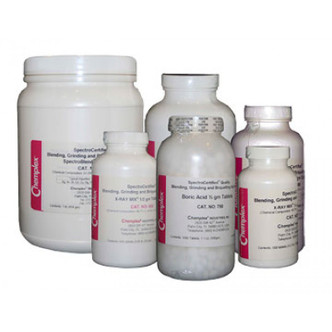Chemplex® additives are formulated with the proper balance of abrasive and lubricious constituents that promote the grinding and pelletizing processes. The resulting sample pellets when the Chemplex® additives are used are characterized with unblemished smooth surface appearing “plasticized”. The Chemplex®additives are available in a variety of formats that make them very simple to use: bulk powder, pre-weighted ¼ and ½ gram tablets. The Chemplex® additives also work well as a diluting agent but the effects of dilution can be minimized by using the least amount of additive.
Grinding/Briquetting Additive Profiles:
|
Additive
|
Chemical Composition
|
|
X-Ray Mix®
|
C: 48.7%; O: 42.6%; H: 8.1%; B: 0.6%
|
|
SpectroBlend®
|
C: 81.0%; O: 2.9%; H: 13.5%; N: 2.6%
|
|
Boric Acid
|
O: 77.6% H: 4.9%; B: 17.5%
|
Note: Some additives may contain trace elements that may potentially interfere with a given analysis. It is suggested that a "Blank" is run to evaluate the presence and interference level prior to an analytical investigation.
® X-Ray Mix, SpectroBlend and Chemplex are registered trademarks of Chemplex Industries, Inc.
- Improve powdered sample preparations
- Reduce particles to uniform size and distribution
- Promote sample homogeneity
- Transform powders into “Plasticized” pellets
- Resolve sample pellet chipping or flaking
Generally, samples deficient in hard abrasive particles evade the effects of grinding and generally tend to agglomerate. The underlying sample particles protected by the outer layers of a sample elude comminution resulting in an increase in heterogeneity. Many other types of samples are comprised of very hard particles, deficient in cohesiveness that tends to resist pelletizing and exhibit fissure development, chipping or flaking apart during handling or analysis. The lubricious constituents of Chemplex® additives impart binding to the sample and conduciveness to briquette formation. The resultant sample pellets are characterized with unblemished smooth surfaces appearing “plasticized.” Frequently, the metallic grinding media is influential to the comminution process. The frictional heat generated by the grinding media tends to soften the sample creating a “caking” effect shielding the underlying mass from further comminution. The recommended starting point is to evaluate a 1 to 2-1/2 wt.% additive-to-sample weight (e.g. 0.1 to 0.25gm additive to 10gm sample). Adjust the additive-to-sample weight ratio until the optimum grinding and briquetting combination is achieved. Reference materials should similarly be prepared for matrix compatibility.
TYPICAL APPLICATIONS
Cement ■ Raw Mix ■ Sinters ■ Slags ■ Catalysts ■ Ores ■ Refractories ■ Fertilizers ■ Soil ■ Phosphate Rock ■ Oxides ■ Alumina ■ Bauxite ■ Carbonates ■ Silicates ■ Organics ■ Inorganics ■ And many other types of sample substances exhibiting difficulty in particle size reduction, distribution and briquetting
|
Additive
|
Prominent Characteristics
|
|
X-Ray Mix®
|
General purpose grinding agent. Balanced for abrasiveness and lubricity to aid in grinding dissimilar particles of moderate hardness for relatively short times. Highly “plasticizes” and firmly bonds samples together under briquetting pressure. Available in pre-weighed ¼ and ½ gm tablets for ease of dispensing.
|
|
SpectroBlend®
|
A 44µm powder well suited for blending and as a diluent for high concentrations. Well balanced with abrasive and lubricious constituents for grinding most sample materials emphasizing difficult-to-process samples requiring long grinding cycles in metallic comminution vials or dishes. Resistant to degradation by thermal and irradiation exposure. Samples have “plasticized” surfaces. Available in bulk powder and ½ gm pre-weighed tablets for ease of dispensing.
|
|
Boric Acid
|
Abrasive substance for processing samples with strong re-welding tendencies. Sample pellets fairly to moderately bond together. Frequently used in conjunction with other additives to impart increased abrasiveness to the grinding process.
|
CONTACT US today for a quote!
 Loading... Please wait...
Loading... Please wait...


